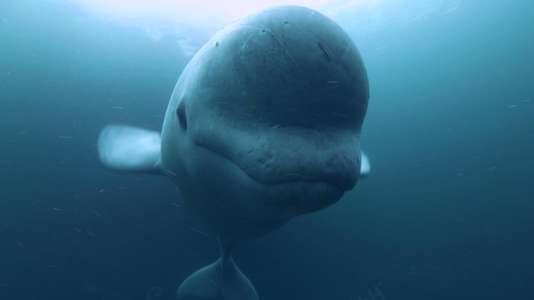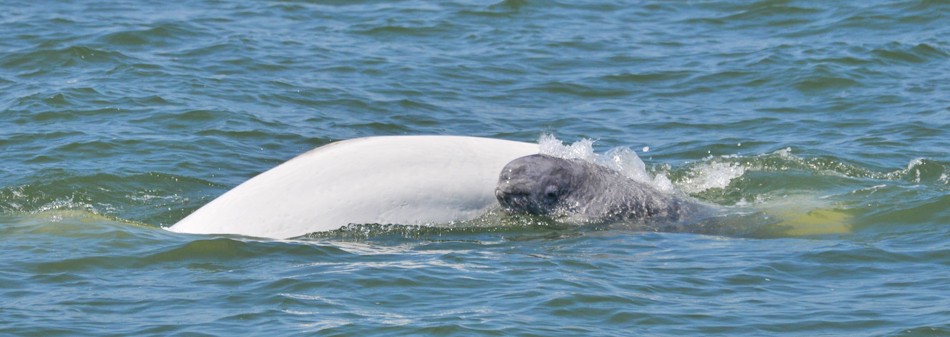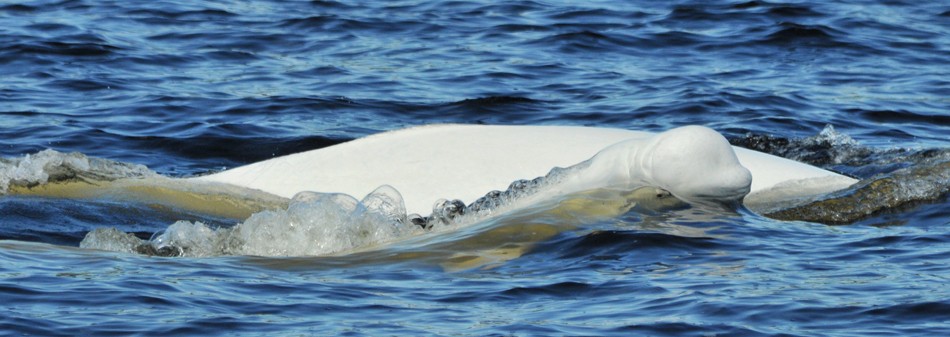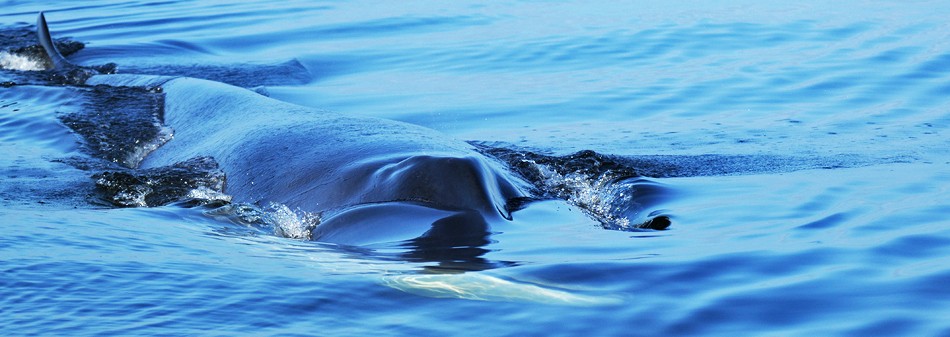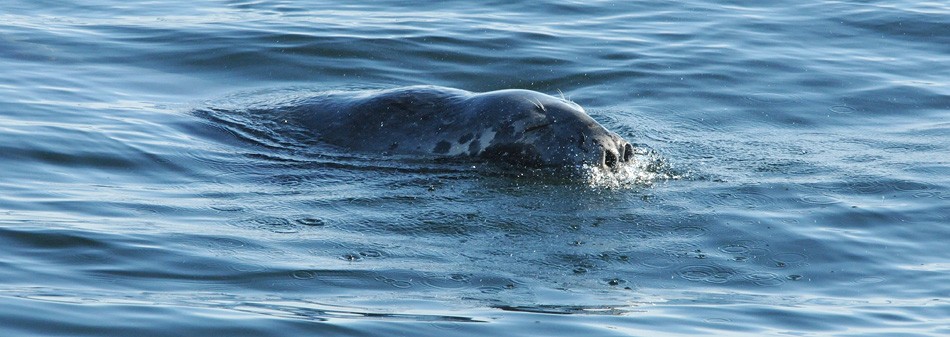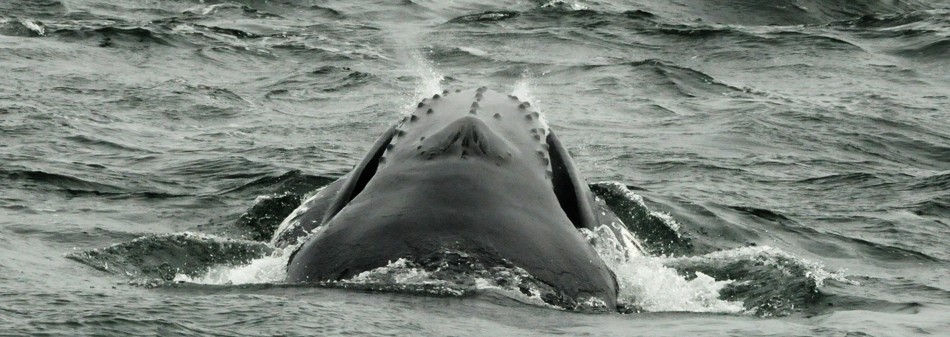28/09/2015
With the Belugas: Week of August 31, 2015

One, two, three…four newborns are surrounding us!
In 18 hours with belugas this week, we conducted four censuses and encountered several herds of females with young and newborns. Here’s one of the highlights!
Afternoon of September 4, 2015: we are with a herd of about 25 belugas on the other side of Île aux Lièvres. The animals are constantly changing direction, swimming in circles and the group compositions are changing every time they surface. We struggle to follow them, but we nevertheless manage to observe a first calf. A few seconds later, a second calf appears 100 m behind the first one. The animals dive. Four minutes later, a large group returns to the surface, the animals are quite close to one another and among them, a third newborn! At the end of the breathing sequence, the group quietly disperses and departs in small groups. And we’re still counting: almost simultaneously, four mother-calf pairs surface, each one some forty metres from the next. This is one of the largest concentrations of calves observed this summer. Although we remain concerned after another year of high mortality of newborn belugas, observations such as these are very encouraging.
Click on the map to navigate with the Bleuvet and discover the highlights of the week!
IDENTIFICATION OF THE WEEK
Yogi – adopted in 1988 by Bell Canada;
DL0204 – available for adoption;
GraCy – adopted in 2003 by Global Reservation Centre;
DL0631 – available for adoption;
Pascolio – adopted in 1990 by Tadoussac Merchants;
and DL0089, DL9031, etc.
The complete list of identified belugas requires meticulous efforts to match individuals, which will be undertaken after the field season.
 Property of the GREMM and the St. Lawrence National Institute of Ecotoxicology, the Bleuvet is a research boat dedicated to the research program on St. Lawrence belugas. Managed by GREMM scientific director Robert Michaud, the Bleuvet crew is composed of Michel Moisan, Tim Perrero and Simon Moisan.
Property of the GREMM and the St. Lawrence National Institute of Ecotoxicology, the Bleuvet is a research boat dedicated to the research program on St. Lawrence belugas. Managed by GREMM scientific director Robert Michaud, the Bleuvet crew is composed of Michel Moisan, Tim Perrero and Simon Moisan.
25/09/2015
With the Belugas: Week of August 24, 2015

MOM, CAN YOU HEAR ME?
This week, the team had 11 encounters in 22 hours with belugas. Two boats were on the water to continue the photo-identification. On board one of them were Robert Michaud and Valeria Vergara, who were undertaking a passive acoustic protocol on the sounds of newborn belugas. GREMM founder Robert Michaud speaks about this new project.
This week: “We are working again with a longtime collaborator and we are relaunching a project that is particularly dear to us. During my stay as resident researcher at the Vancouver Aquarium in 2007-2008, I discovered the work of Valeria Vergara who was studying communication development in beluga newborns. Valeria notably used the recordings we had made in the St. Lawrence to demonstrate the alert function of the first cries learned by young belugas. This week, we are working together in the Saguenay Fjord to assess the possibility of studying the impact of noise on communication between mothers and their calves. In the first few weeks of life, the calves’ “contact” cries are emitted at relatively low frequencies that are easily masked by the sound of boats. This is a challenging project, but an important one. We managed several very good recordings this week… The pilot project is conclusive. Funding remains to be secured to ensure the kick-off of the project next summer. At the present time, we believe that we will need two or three seasons to conduct this new study.”
Click on the map to navigate with the Bleuvet and discover the highlights of the week!
IDENTIFICATION OF THE WEEK
Yogi – adopted in 1988 by Bell Canada;
Pacalou– adopted in 2006 by Pascale Cauchi;
Pure Laine – adopted in 2014 by Cynthia Fish;
Miss Frontenac – adopted in 2008 by Fairmont Le Château Frontenac;
Blanche – adopted in 2014 by the municipality of Tadoussac;
and DL1508, DL9018…
The complete list of identified belugas requires meticulous efforts to match individuals, which will be undertaken after the field season.
 Property of the GREMM and the St. Lawrence National Institute of Ecotoxicology, the Bleuvet is a research boat dedicated to the research program on St. Lawrence belugas. Managed by GREMM scientific director Robert Michaud, the Bleuvet crew is composed of Michel Moisan, Tim Perrero and Simon Moisan.
Property of the GREMM and the St. Lawrence National Institute of Ecotoxicology, the Bleuvet is a research boat dedicated to the research program on St. Lawrence belugas. Managed by GREMM scientific director Robert Michaud, the Bleuvet crew is composed of Michel Moisan, Tim Perrero and Simon Moisan.
18/09/2015
With the Belugas: Week of August 17, 2015

Good news for calves! In 14 hours with belugas, we conducted four censuses and a total of 10 calves were observed. Here is one impressive series of events for the week.
August 20, 2015, 12:50 pm: The shallow waters south of Île Rouge are often the scene of interesting encounters. Skirting the western tip of the island, we spot a herd of about sixty individuals, including adults and young. Quickly, our attention is diverted by a highly agitated group. Forceful splashing, tail-slapping, sudden changes of direction…and a pink spot on a white belly. As we approach them, we discover that these belugas are engaged in sexual activities. These pink spots are actually penises; during this observation, we would see many. In fact, ten young males (of considerable size, but not entirely white) surround a young female. She is still quite gray. The males prevent the female from escaping. Several of them attempt to mate with her. Although we are outside the breeding season (belugas breed in the spring), we occasionally witness sexual activities in summer. These sessions might be a training of sorts! The participation of multiple males is not unusual. Given that adult females can give birth to one calf only once every three years, each year there are far fewer females available for reproduction than males who are eager to pass on their genes. We believe that the formation of companion groups in adult male belugas is actually a collaborative strategy to monopolize access to females during the breeding season. In summer, the young males might be training for these essential activities.
Click on the map to navigate with the Bleuvet and discover the highlights of the week!
IDENTIFICATION OF THE WEEK
Annakpok – adopted in 1992 by Canada Steamship Lines
DL0058 – Available for adoption
DL9031
DL0473
DL1610
DL2217
 Property of the GREMM and the St. Lawrence National Institute of Ecotoxicology, the Bleuvet is a research boat dedicated to the research program on St. Lawrence belugas. Managed by GREMM scientific director Robert Michaud, the Bleuvet crew is composed of Michel Moisan, Tim Perrero and Simon Moisan.
Property of the GREMM and the St. Lawrence National Institute of Ecotoxicology, the Bleuvet is a research boat dedicated to the research program on St. Lawrence belugas. Managed by GREMM scientific director Robert Michaud, the Bleuvet crew is composed of Michel Moisan, Tim Perrero and Simon Moisan.
17/09/2015
Pregnancy Tests for Belugas
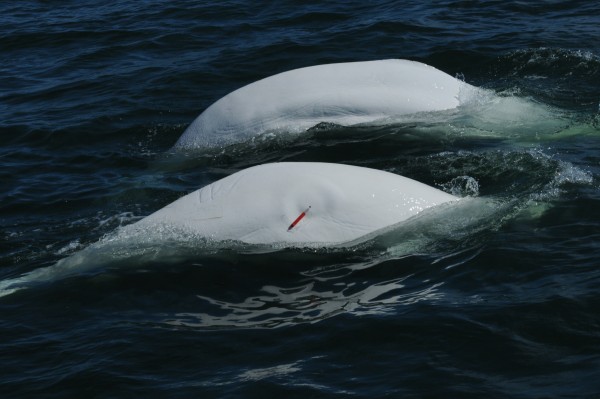
This project is being led by researcher Véronique Lesage (Fisheries and Oceans Canada) in collaboration with the GREMM, Saint Mary’s University in Nova Scotia and Florida Atlantic University’s Harbor Branch Oceanographic Institute. The objective is to determine whether the proportion of female belugas that are pregnant is comparable to the figure which might be expected in a healthy population, i.e. about one third of adult females.
The project is in its third year and runs from approximately September 8 to 25. This period is scheduled quite far from the peak for births (July) in order to produce a representative picture and hope for favourable weather conditions for the offshore team combing beluga habitat aboard the Bleuvet. Progesterone is a hormone produced by the ovaries and the level of which varies depending on whether or not the female is pregnant. These variations are detectable in tiny fat samples that can be taken during biopsies. The collected biopsies can also be used for other projects on the beluga nutrition, physiological condition, contamination or genetics. After a one week of work, 22 biopsies have already been successfully completed. The team is satisfied with the course of events and is hopeful that it will continue until the end!
To learn more:
15/09/2015
With the Belugas: Week of August 10, 2015
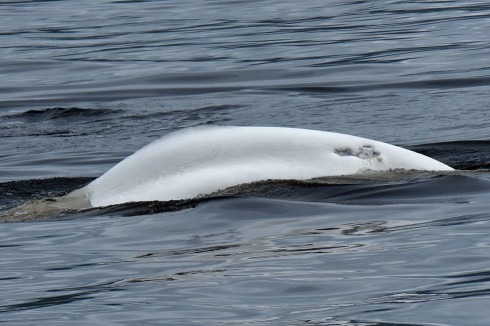
YOGI SWIMS UP THE SAGUENAY ALONE
This week, fog is prevalent. Our observations had to be cut short. Nevertheless, we managed to conduct three censuses and spent 12 hours with belugas. Here is one noteworthy story for the week.
Throughout the week, we observed Yogi twice, on August 13 and 14, swimming alone up the Saguenay along the cliffs. Yogi is a highly fertile female first observed in 1986. Unlike the majority of the females that we know, Yogi tends to avoid groups. This year the trend is even more pronounced, she is quite emaciated and spends a great deal of time on the surface! Belugas are far from being solitary animals. They live in pairs and groups of 3 to several dozen individuals or clans, governed according to sex- or age-based segregation. In summer, females even form large communities in which they care for newborns and young. These communities are associated with traditional territories.
IDENTIFICATION OF THE WEEK
Pascolio – adopted in 1990 by Tadoussac business owners
Yogi – adopted in 1988 by Bell Canada DL9031
Dl1688
DL1007
The complete list of identified belugas requires meticulous efforts to match individuals, which will be undertaken after the field season.
 Property of the GREMM and the St. Lawrence National Institute of Ecotoxicology, the Bleuvet is a research boat dedicated to the research program on St. Lawrence belugas. Managed by GREMM scientific director Robert Michaud, the Bleuvet crew is composed of Michel Moisan, Tim Perrero and Simon Moisan.
Property of the GREMM and the St. Lawrence National Institute of Ecotoxicology, the Bleuvet is a research boat dedicated to the research program on St. Lawrence belugas. Managed by GREMM scientific director Robert Michaud, the Bleuvet crew is composed of Michel Moisan, Tim Perrero and Simon Moisan.
11/09/2015
With the Belugas: Week of August 3
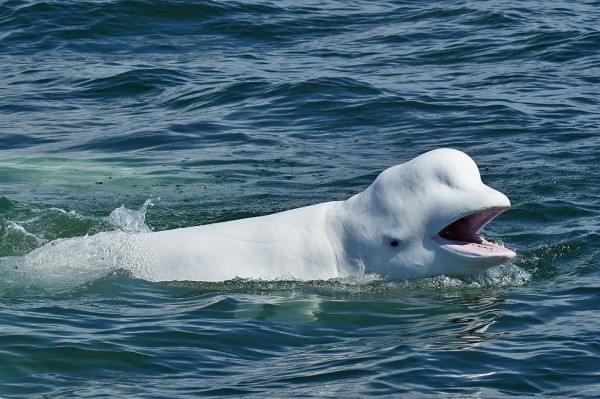
A BELUGA THAT SHOWS ITS TEETH
Several hours at sea for Week 6 in the field! In total: 20 hours with belugas and 5 censuses. We encountered a number of herds, each of which numbered about fifty individuals. The following is an encounter with an individual exhibiting remarkable behaviour!
Friday, August 7, 2015: this happened at the end of an encounter with a herd of young adults. There are about 80 animals, split up into no less than nine groups. It’s late morning, and we’re near Île aux Pommes off of Trois-Pistoles. It’s an ideal day with perfect visibility and hardly any waves. Despite the active behaviour of the animals (they are swimming in circles and vocalizing at the water surface), which complicates the task of photo taking, we manage to snap a number of pictures of animals with marks allowing for identification. Just before leaving, a large male approaches us, sticks his head out of the water and chatters his teeth several times! We are taken aback by this most extraordinary behaviour! Why does he do it? That remains a mystery…
THE WHALES IDENTIFIED THIS WEEK
DL1050 – available for adoption
DL0269 – available for adoption
DL0248 – available for adoption
Blanche – adopted in 2014 by the municipality of Tadoussac
Céline – adopted in 1997 by Leslie B. Durst
Jetstream – adopted in 2002 by The Fairmount Vancouver Airport
DL0370 – adopted in 2014 by the Vancouver Aquarium
 Property of the GREMM and the St. Lawrence National Institute of Ecotoxicology, the Bleuvet is a research boat dedicated to the research program on St. Lawrence belugas. Managed by GREMM scientific director Robert Michaud, the Bleuvet crew is composed of Michel Moisan, Tim Perrero and Simon Moisan.
Property of the GREMM and the St. Lawrence National Institute of Ecotoxicology, the Bleuvet is a research boat dedicated to the research program on St. Lawrence belugas. Managed by GREMM scientific director Robert Michaud, the Bleuvet crew is composed of Michel Moisan, Tim Perrero and Simon Moisan.
03/09/2015
New Version of Large Rorqual Catalogue Released!
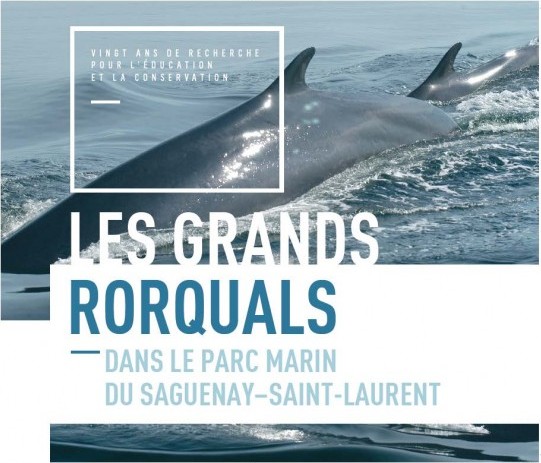
The Group for Research and Education on Marine Mammals (GREMM) and Parks Canada, along with their financial partners Fondation de la faune du Québec (FFQ) and the Société des établissements de plein air au Québec (SÉPAQ), are publishing a work on large rorquals faithful to the Saguenay–St. Lawrence Marine Park region.
This unparallelled catalogue is ideal for any captain, naturalist or simply whale enthusiast who wishes to discover a new chapter in the lives of these titans. Every year, the same whales return from their migration to feed in the Estuary and Gulf of St. Lawrence; the most famous “faces” are gathered in this book, which is divided into three sections. It describes the oceanographic characteristics of the St. Lawrence ecosystem that make this area a genuine smorgasbord for marine wildlife. It also contains a description of scientific research that has been carried out in the Marine Park over the past 20+ years and the results of these studies, as well as other unpublished news. Lastly, over 40 whales are featured (fin whales, humpbacks, blue whales and minke whales) that have been identified in the Marine Park since the 1980s, along with their stories and tips to distinguish them individually.
Extracts from the catalogue:
This catalogue was presented and given to tour captains during the Eco-Whale Alliance’s seasonal autumn meeting held on September 1. This catalogue is a valuable tool in the context of their work. A more detailed version for the general public is on sale at the Marine Mammal Interpretation Centre (CIMM) in Tadoussac and at AML cruise ticket outlets. Profits generated by the sale of this book will go toward the Eco-Whale Alliance Fund, which supports research and education on large rorquals, offshore observation activities and continuing education of captains and naturalists.
To learn more:
About the Eco-Whale Alliance
24/08/2015
Increasingly tuned in to whales, Whales Online presents its new colours in french and english
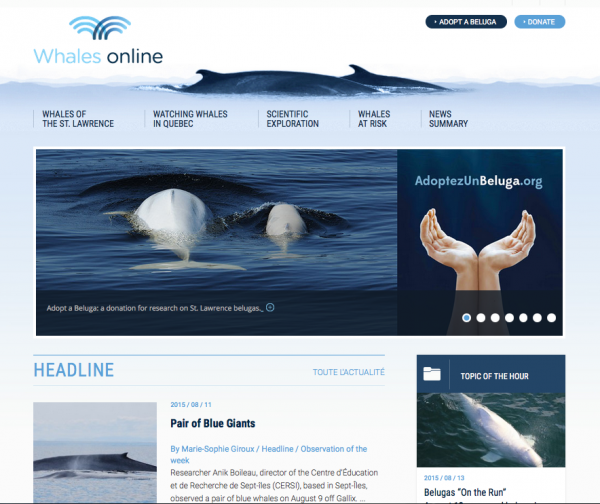
For its 15th anniversary, the reference site on whales of the St. Lawrence has been completely revamped. With a broader network of collaborators and new columnists, Whales Online provides comprehensive coverage of news about whales here and elsewhere, week after week. Through News from Afield and Field Notes, from the Côte-Nord to the Gaspé and upstream to the Saguenay–St. Lawrence Marine Park, some forty experienced observers and research teams relay their observations and share their most noteworthy moments. With a brand new look and thanks to the support of the Government of Canada’s National Conservation Plan and the Donner Canadian Foundation, the English version of Whales Online is back.
A tool for the discovery and conservation of whales and the St. Lawrence
WhalesOnline.org is an initiative of the Group for Research and Education on Marine Mammals (GREMM). As a dynamic and constantly evolving platform, the site revolves around a copiously illustrated encyclopedia-like section that discusses cetaceans and the St. Lawrence, whale-watching in Quebec, research and conservation. For Gréta Fougère, General Director of the Association touristique de Manicouagan, “the Whales Online site is a tremendous tool to discover the world of whales before actually coming to see them on the Whale Route between Tadoussac to Blanc-Sablon”.
The Whales Online website, with its bulletin Portrait de Baleines, also plays a role in the continuous education of captains and naturalists belonging to the Eco-Whale Alliance. Partners of this Alliance, namely whale-watching cruise operators in the Marine Park as well as Parks Canada and Parcs Québec – co-managers of the Saguenay–St. Lawrence Marine Park – receive news on research programs from a vast network of collaborators and the Quebec Marine Mammal Emergency Response Network. Jérôme Gouron co-director of the Marine Park: “It’s a wonderful tool both for visitors who are interested in learning more about whales, and for captains and naturalists who can stay up to date on sightings in the Saguenay–St. Lawrence Marine Park.”
Over 3,500 subscribers already receive the free Whales Online newsletter every week. And that number keeps growing, as does the number of subscribers on the social networks affiliated with Whales Online. GREMM Scientific Director Robert Michaud shares his excitement: “Having Whales Online in English again is fantastic. In fact, we are now capable of reaching everyone throughout Quebec and the rest of Canada. Over the years, we have become increasingly convinced that by sharing the whales’ stories, we can change the world, little by little.”
The different “faces” of Whales Online over the years:
03/08/2015
With the Belugas: Week of July 27
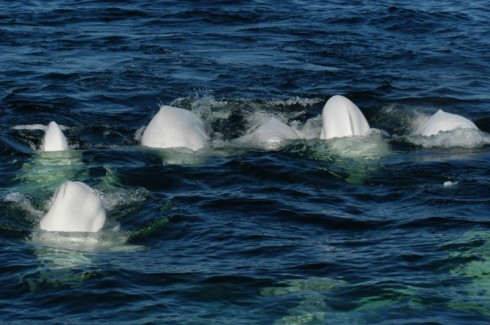
BELUGAS AND WAVES!
It’s been a tough week for working out at sea. However, we have completed three surveys and logged over 20 hours at sea, including 11 spent with belugas: many wonderful encounters and a few frustrations. Here are a few excerpts!
Tuesday, July 28, 2015: We can already hear thunder, the waves are high and the weather forecast is calling for more storms to come. It’s a real challenge to find and track belugas in such conditions. Yet this is the reality of field work; we seek out every possible opportunity to be at sea with belugas… the season is passing by quickly! After an initial contact in choppy waters downstream from Île Rouge, we find a calmer area south of the island: a herd of adults and young is here. A female accompanied by a newborn attracts our attention and convinces us to pursue this new contact. Particular attention is paid to mother-young pairs. Before we can conclude that the newborn is indeed accompanied by its mother, we need to continue observing for a while. In fact, sometimes, a mother leaves her little one for a few moments, at which point it might be accompanied by another adult or even occasionally by a young beluga. However, the weather conditions prevent us from completing this observation. Fog closes in on the boat. We leave somewhat frustrated, but with images of a mother-young duo…to be confirmed.
Some of the whales identified this week include:
Céline – adopted in 1997 by Leslie B. Durst;
Blanche – adopted in 2014 by the municipality of Tadoussac;
DL0030 – available for adoption by participants of a collective adoption;
Aquabelle – adopted in 2014 by the Aquarium du Québec;
Miss Frontenac – adopted in 2008 by Fairmont Le Château Frontenac;
Dimitri;
DL0393;
DL1793;
DL0595.
 Property of the GREMM and the St. Lawrence National Institute of Ecotoxicology, the Bleuvet is a research boat dedicated to the research program on St. Lawrence belugas. Managed by GREMM scientific director Robert Michaud, the Bleuvet crew is composed of Michel Moisan, Tim Perrero and Simon Moisan.
Property of the GREMM and the St. Lawrence National Institute of Ecotoxicology, the Bleuvet is a research boat dedicated to the research program on St. Lawrence belugas. Managed by GREMM scientific director Robert Michaud, the Bleuvet crew is composed of Michel Moisan, Tim Perrero and Simon Moisan.
26/07/2015
With the Belugas: Week of July 20
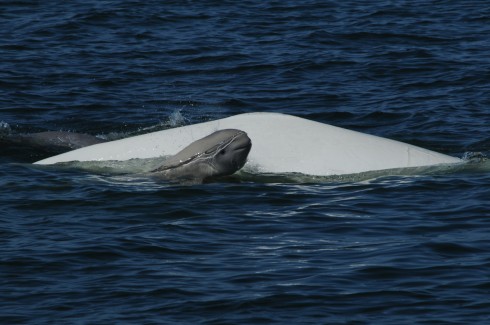
We are in the 4th week of field work for the St. Lawrence beluga behavioural study. We have gone out on the water on two days during which we logged 9 hours of observations for 15 hours at sea.
We first explored the Saguenay Fjord sector, from Caribou-Qui-Pisse Falls to Baie Sainte-Marguerite. We also patrolled the waters of the municipality of Petit-Saguenay, more specifically around Pointe aux Crêpes. We later explored the mouth of the Saguenay Fjord off of Baie-Sainte-Catherine and as far as east-central Île Blanche. The weather during the last two excursions was problematic: poor visibility, periods of fog and rain, strong waves and heavy cloud cover. In total we observed 3 herds numbering about 15 adults and gray young as well as a herd of 80 individuals composed of females, grays and one calf. The animals were rather dynamic: surface activities, milling (repeated diving and resurfacing at the same spot), vocalizations and multidirectional movement.
Tuesday July 21, 2015 The numerous waves form whitecaps, complicating our task of spotting belugas under the circumstances. Nevertheless, we manage to get a number of photos of belugas showing distinctive markings. Within the herd we recognize Céline, who is swimming with her calf which is at least one year old. The latter has a deformity that makes it appear hunchbacked, a little like Pascolio, a well known female in the Saguenay sector that suffers from lordosis, i.e. a concave curvature of the vertebral column. A number of belugas showing deformities also found in humans (lordosis, scoliosis) frequent the waters of the St. Lawrence and the Saguenay. Pascolio, Scolio, Néo and others are more easily recognizable by this characteristic, but photos are often necessary to confirm an identification made in the field.. Then, toward the end of our observation, we encounter two “grays” that we had not yet seen this season that are moving in the opposite direction of our herd. They quickly swim away, leaving the herd behind.
Thursday, July 23, 2015: We observe a large herd of some 80 individuals, highly dynamic and active at the surface. As they are vocalizing quite a bit, we decide to drop our hydrophone into the water to record the underwater sounds. The herd splits into groups of about a dozen individuals and it is increasingly difficult to keep count. We snap off a few photos when we spot an individual with a very distinctive dorsal crest. It makes for a good candidate for a biopsy, which we complete successfully.
Here is the star observed this week: Céline
 The Bleuvet is a boat belonging to the GREMM. It is dedicated to the long-term research program on St. Lawrence belugas.
The Bleuvet is a boat belonging to the GREMM. It is dedicated to the long-term research program on St. Lawrence belugas.


